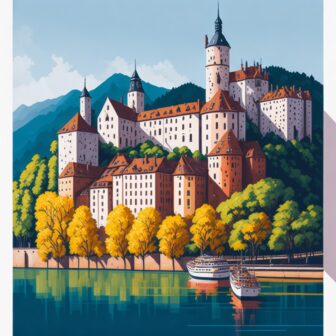9 Best UNESCO World Heritage Sites in Germany
Germany is a country brimming with cultural and natural treasures, as evidenced by its numerous UNESCO World Heritage Sites. From pristine beech forests to ancient Roman ruins and magnificent palaces, there is an abundance of remarkable destinations waiting to be explored.
I will take you on a virtual journey through Germany’s top nine UNESCO World Heritage Sites, providing detailed insights into each location’s historical significance, architectural wonders, and natural beauty.
1. Upper Middle Rhine Valley, Rhineland-Palatinate: Where Panoramic Views Meet Romantic Towns
Nestled in Rhineland-Palatinate, the Upper Middle Rhine Valley stretches for 67 kilometers between Bingen and Koblenz. This stunning river landscape, listed as a UNESCO World Heritage Site since 2002, offers breathtaking panoramic views that will leave you in awe.
The region is famed for its iconic Loreley Rock, which stands tall amidst the verdant vineyards and picturesque small towns dotting the Rhine riverbanks. As you traverse this enchanting valley, don’t forget to visit the German Corner in Koblenz, where the Moselle river converges with the Rhine. Additionally, the Ehrenbreitstein Fortress in Koblenz provides a phenomenal vantage point to soak in the beauty of the German Corner.
2. Historic Old Town of Bamberg, Bavaria: A Journey Through Medieval Architecture
Located in the Franconian cultural landscape of Bavaria, the historic old town of Bamberg boasts a rich tapestry of architectural wonders. Since 1993, this charming city has held the esteemed UNESCO World Heritage Site status, earning it the moniker of “Franconian Rome.” With approximately 2,400 listed buildings, Bamberg’s old town is a visual feast for history enthusiasts.
Immerse yourself in the architectural masterpieces dating back to the High Middle Ages, with the Kaiserdom (Imperial Cathedral) serving as the symbolic center. The baroque New Residence and the Brückenrathaus (Bridge Town Hall) are also among the city’s popular attractions. After exploring the architectural marvels, be sure to indulge in Bamberg’s famous beers and partake in beer tastings offered in the city.
RELATED:
Best Places to Visit in Bamberg
3. Würzburg Residence, Bavaria: A Baroque Gem Inspired by Versailles
Prepare to be transported to a world of Baroque splendor at the Würzburg Residence, one of Germany’s most impressive architectural gems. This UNESCO World Heritage Site, designated in 1981, is located in Bavaria and exudes grandeur reminiscent of the Palace of Versailles in Paris. Construction of the Würzburg Residence commenced in 1720 and lasted over six decades.
The highlight of the residence is undoubtedly the splendid Court Garden, which adds to the overall magnificence of the structure. Be sure to marvel at the breathtaking frescoes created by Giovanni Battista Tiepolo, the renowned 18th-century fresco painter. Discover the opulence and beauty that define the Würzburg Residence.
4. Ancient Beech Forests, Thuringia: Nature’s Time Capsule
Nature enthusiasts and history buffs alike will be captivated by the Ancient Beech Forests, a UNESCO World Heritage Site since 2011. Encompassing an expansive area of nearly 1,000 square kilometers, the majority of this protected region lies within the Hainich National Park in Thuringia. However, other beech primeval forests can also be found in Hesse, Brandenburg, and Mecklenburg-Vorpommern.
These ancient forests offer a fascinating window into the natural history of Europe, showcasing the ecological richness and biodiversity that thrived over centuries. Fun fact: Did you know that approximately 6,500 years ago, around 40% of the European continent was covered by beech forests? Today, the UNESCO World Heritage Site of beech primeval forests spans twelve European countries, extending from Spain to Ukraine.
5. Museum Island, Berlin: Where 6,000 Years of History Unfold
Step into the cultural heart of Germany at Museum Island, a UNESCO World Heritage Site in Berlin since 1999. With its five remarkable buildings and an extensive collection spanning 6,000 years of history, Museum Island stands as a testament to human achievement.
Explore the Old Museum, the New Museum, the Alte Nationalgalerie (Old National Gallery), the Bode Museum, and the Pergamon Museum, each housing exquisite archaeological finds and magnificent works of art. Notably, the bust of Nefertiti is a must-see exhibit that captivates visitors with its timeless beauty.
As you navigate through this cultural haven, don’t miss the James-Simon-Galerie, an architectural masterpiece designed by the acclaimed British architect David Chipperfield. Serving as the central entrance and visitor center, it adds a contemporary touch to the historical landscape of Museum Island.
RELATED:
Best Places to Visit in Berlin
1 Day Itinerary in Berlin
6. Cologne Cathedral, North Rhine-Westphalia: A Gothic Marvel of Architectural Triumph
Prepare to be awestruck by the grandeur of Cologne Cathedral, an iconic UNESCO World Heritage Site. Situated in North Rhine-Westphalia, this masterpiece of Gothic architecture began its construction around 1248 and was finally completed in 1880.
The cathedral’s twin towers, which once held the title of the world’s tallest building, continue to dominate the skyline, captivating visitors from near and far. Journey inside the cathedral’s treasury to behold a collection of valuable relics and treasures, including the revered Chain of Saint Peter. Enhancing the cathedral’s allure are the regular organ concerts that fill the sacred space with mesmerizing melodies.
Fun fact: The site where Cologne Cathedral stands today has housed several smaller churches since the early 4th century, adding layers of historical significance to this architectural marvel.
7. Roman Monuments, Trier, Rhineland-Palatinate: A Glimpse into Ancient Roman Civilization
Unravel the mysteries of ancient Rome at the Roman Monuments in Trier, the oldest city in Germany and a UNESCO World Heritage Site since 1986. Once known as Augusta Treverorum, Trier boasts a wealth of Roman ruins that shape the city’s landscape and provide a cultural treasure trove for history enthusiasts. Marvel at the majestic Porta Nigra, the city’s iconic symbol, or explore the remnants of the ancient Roman baths at the Imperial Baths.
Every step you take in Trier feels like a journey back in time, immersing you in the grandeur and legacy of the Roman Empire. Discover the historical significance of Trier, a city that bears witness to over two millennia of human history.
RELATED:
Best Places to Visit in Trier
Living History Museums in Germany
8. Völklingen Ironworks, Saarland: A Testament to Industrial Heritage
Immerse yourself in the industrial legacy of Germany at the Völklingen Ironworks, the world’s last remaining ironworks from the 19th-century industrial era. Designated as a UNESCO World Heritage Site in 1994, this sprawling industrial complex spans over 600,000 square meters.
Once a thriving hub of iron production, the Völklingen Ironworks has since transformed into a cultural site, offering visitors a glimpse into the achievements of engineering and industrial prowess of its time. Explore the massive blower hall, covering an impressive 6,000 square meters, and gain a profound appreciation for the dimensions and innovations that shaped the industrial landscape.
Follow the well-sign posted six-kilometer-long circular trail to fully experience the historical significance and architectural grandeur of the Völklingen Ironworks.
9. Augustusburg and Falkenlust Palaces, Brühl, North Rhine-Westphalia: A Tapestry of Baroque and Rococo Splendor
In the quaint town of Brühl, North Rhine-Westphalia, lies a cultural gem recognized by UNESCO as a World Heritage Site since 1984—the Augustusburg and Falkenlust Palaces.
Despite its modest size, Brühl boasts architectural wonders that showcase the opulence of the Rococo and Baroque styles. The construction of Augustusburg Palace commenced in 1725 and spanned four decades, resulting in a breathtaking structure that exemplifies the grandeur of the era.
Strolling through the Baroque gardens, meticulously designed based on the French model, reveals the striking contrast between architectural styles. As you explore these palatial grounds, keep an eye out for the palace concerts held during the summer months—an opportunity to revel in the harmonious fusion of music and historical surroundings.
Germany’s UNESCO World Heritage Sites offer a captivating blend of history, culture, and natural wonders. From the romantic allure of the Upper Middle Rhine Valley to the architectural marvels of Cologne Cathedral and the Würzburg Residence, each location promises a unique experience that transports you to a different era. Whether you’re an avid history buff, an architecture enthusiast, or a nature lover, these nine sites will leave an indelible mark on your journey through Germany. Embark on this captivating voyage of exploration and immerse yourself in the rich tapestry of Germany’s cultural and natural heritage.






